Dipinti di Tullio De Franco

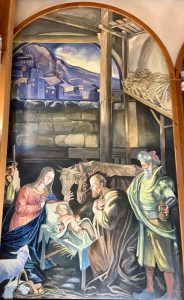
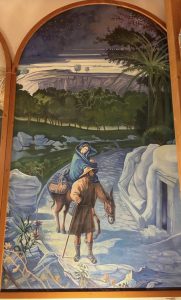
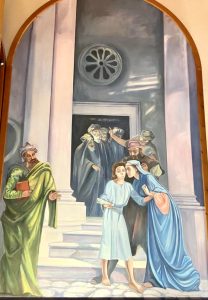
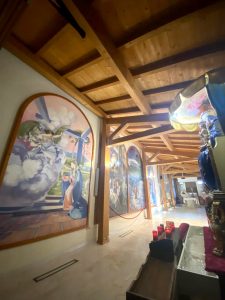
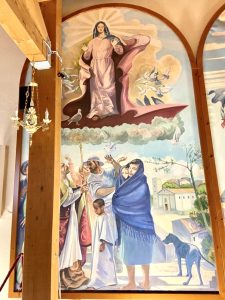
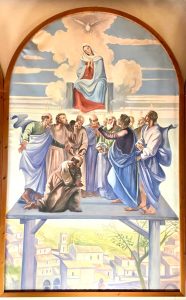
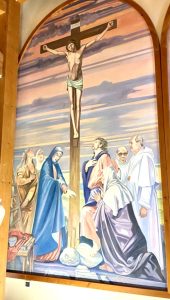
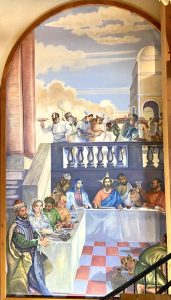
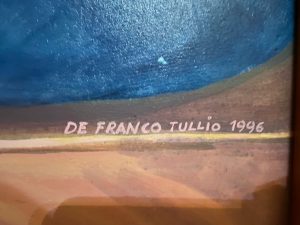
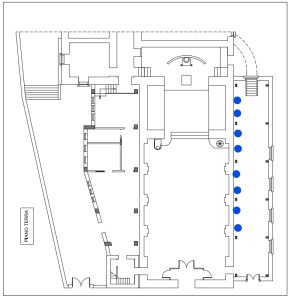

Parrocchia Santuario Maria SS. di Carpignano
Dipinti
Scene di Vita di Maria e di Gesù
Tullio De Franco
Sec. XX
Olio su tela

Parish Sanctuary Maria SS. di Carpignano
Paintings
Scenes from the Life of Mary and Jesus
Tullio De Franco
XX century
Oil painting on canvas
Tullio De Franco nasce a Foggia nel 1934. Abbandonati gli studi classici si dedicò alla pittura frequentando prima il liceo artistico e poi l’accademia di Belle Arti di Napoli. Insegnò Discipline Pittoriche al I° Liceo Artistico di Roma, poi Pittura all’Accademia di Belle Arti RUFA.
Prese parte a numerose rassegne, premi d’arte e mostre, personali e collettive, in spazi pubblici e gallerie private, in Italia e all’estero. Per alcuni anni visse ad Avellino e in Irpinia lasciando numerose opere, tra cui, il mosaico monumentale che decora la cripta paleocristiana del Duomo di Avellino. È morto a Roma nel 2011.
Nel Santuario di Carpignano sono conservate otto tele raffiguranti scene della vita di Maria e di Gesù. Nello specifico le tele raffigurano: l’Annunciazione, la nascita di Gesù, la fuga dall’Egitto, il ritrovamento di Gesù nel tempio, le nozze di Cana, la crocifissione di Gesù, la discesa dello Spirito Santo, l’assunzione della Vergine.
Le opere furono volute dai padri Mercedari Pasquale Pasquariello e Nicola Di Rienzo, rispettivamente, padre superiore e parroco del Santuario, per decorare le cappelle laterali della Chiesa dopo il terremoto del 1980. Successivamente, con il restauro e il rinnovamento della Chiesa, sono state adagiate nella cappella laterale.
Nel primo quadro è raffigurata in primo piano la Vergine in atteggiamento di umiltà allorchè irrompe l’annuncio tramite l’apparizione dell’Arcangelo Gabriele.
Nel secondo quadro è raffigurata la capanna di Betlemme illuminata dalla presenza del Bambino ed un borgo montano con le case illuminate in attesa di eventi soprannaturali che segnano il tempo.
Nel terzo quadro è raffigurata la S. Famiglia che, solitaria, erra per strade di campagna e Giuseppe in cerca di accoglienza incrocia con lo sguardo una casa sbarrata: ciò sta a ricordare che anche Gesù fu esule. E’ questa una rappresentazione assolutamente attuale in quanto il pensiero va subito su migranti ed esuli di altre terre che arrivano nel nostro paese.
Nel quarto quadro è raffigurato il ritrovamento di Gesù dodicenne nel tempio. Il messaggio della raffigurazione è la ricerca della verità, i dotti della legge disputavano e non si rendevano conto che la verità era a portata di mano.
Nel quinto quadro vi è la raffigurazione delle nozze di Cana dove avvenne il primo miracolo di Gesù per implorazione della Madonna.
Nel sesto quadro vi è la raffigurazione della crocifissione ed in questa tela l’autore si è ispirato ad Antonello da Messina. Alla maniera rinascimentale sono raffigurati anche i committenti, ossia, Padre Pasquale Pasquariello e Padre Nicola Di Rienzo, Superiore del Santuario della Madonna di Carpignano, che con la veste del loro Ordine stanno a confermare la continuità della redenzione tramite la responsabile opera dei ministri di Dio con la ripetizione sull’altare del sacrificio del Calvario.
Nel settimo quadro vi è la raffigurazione della discesa dello Spirito Santo e tra gli undici apostoli vi è in trono la Vergine. Gli apostoli sono sopra un tavolato al di sotto del quale si intravede la Cattedrale di Ariano Irpino.
Nell’ottavo quadro è raffigurata l’Assunzione e ad assistere non sono gli apostoli, come nell’Assunta del Tiziano, ma tante persone di varia estrazione che testimoniano, con la fede, la pietà verso la Madonna di Carpignano la cui chiesa viene riportata nello sfondo a destra; segue una madre irpina con il bambino a rappresentare le donne devote; segue il fanciullo nero davanti a lei per rappresentare gli immigrati extracomunitari. Sono inoltre raffigurati un contadino che rappresenta l’ambiente agricolo in cui si trova il Santuario, un vescovo che rappresenta la chiesa, due militari della Bosnia di quel periodo.
In conclusione, le otto tele testimoniano non solo l’arte contemporanea a riprova del livello culturale che essa ha raggiunto ma anche per indicare la didattica contenuta nelle rappresentazioni pittoriche ossia la problematica morale e sociale del nostro tempo nel mondo ed in particolare nell’Irpinia.
M. V.
Tullio De Franco was born in Foggia in 1934. After abandoning his classical studies, he devoted himself to painting, first attending the artistic high school and then the Academy of Fine Arts in Naples. He taught Painting Disciplines at the 1st Art School in Rome, then Painting at the RUFA Academy of Fine Arts.
He took part in numerous reviews, art awards and exhibitions, personal and collective, in public spaces and private galleries, in Italy and abroad. For some years he lived in Avellino and Irpinia, leaving numerous works, including the monumental mosaic that decorates the early Christian crypt of the Cathedral of Avellino. He died in Rome in 2011.
In the Sanctuary of Carpignano there are eight paintings depicting scenes from the life of Mary and Jesus. Specifically, the paintings depict: the Annunciation, the birth of Jesus, the flight from Egypt, the finding of Jesus in the temple, the wedding at Cana , the crucifixion of Jesus, the descent of the Holy Spirit, the assumption of the Virgin.
The works were commissioned by the Mercedary fathers Pasquale Pasquariello and Nicola Di Rienzo, respectively, father superior and parish priest of the Sanctuary, to decorate the side chapels of the Church after the 1980 earthquake. Subsequently, with the restoration and renewal of the Church, they were placed in the side chapel.
In the first painting the Virgin is depicted in the foreground in an attitude of humility when the announcement breaks through the apparition of the Archangel Gabriel.
The second painting depicts the Bethlehem hut illuminated by the presence of the Child and a mountain village with illuminated houses awaiting supernatural events that mark the time.
In the third picture the Holy Family is depicted which, alone, wanders through country roads and Joseph in search of welcome crosses a barred house with his eyes: this is a reminder that Jesus was an exile too. This is an absolutely current representation as the thought immediately goes to migrants and exiles from other lands arriving in our country.
The fourth painting depicts the finding of twelve-year-old Jesus in the temple. The message of the representation is the search for the truth, the scholars of the law disputed and did not realize that the truth was at hand.
In the fifth picture there is the representation of the wedding at Cana where the first miracle of Jesus took place at the request of the Madonna.
In the sixth painting there is the depiction of the crucifixion and in this canvas the author was inspired by Antonello da Messina. The patrons are also depicted in the Renaissance style, namely, Father Pasquale Pasquariello and Father Nicola Di Rienzo, Superior of the Sanctuary of the Madonna di Carpignano, who with the robe of their Order confirm the continuity of redemption through the responsible work of the ministers of God. with the repetition on the altar of the sacrifice of Calvary.
In the seventh picture there is the depiction of the descent of the Holy Spirit and the Virgin is enthroned among the eleven apostles. The apostles are on a table below which you can see the Cathedral of Ariano Irpino.
In the eighth picture the Assumption is depicted and it is not the apostles who assist, as in Titian’s Assumption, but many people of various origins who testify, with faith, to the piety towards the Madonna of Carpignano whose church is brought back to the right background; Then comes an Irpinia mother with her child to represent devoted women; then comes the black boy in front of her to represent non-EU immigrants. Also depicted are a peasant who represents the agricultural environment in which the Sanctuary is located, a bishop who represents the church, two Bosnian soldiers of that period.
In conclusion, the eight canvases testify not only to contemporary art as proof of the cultural level it has reached but also to indicate the didactics contained in pictorial representations, that is, the moral and social problems of our time in the world and in particular in Irpinia.
M. V.
